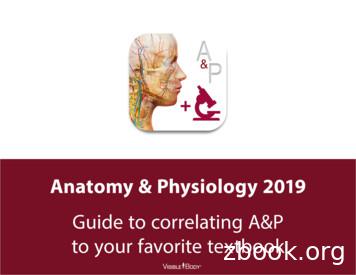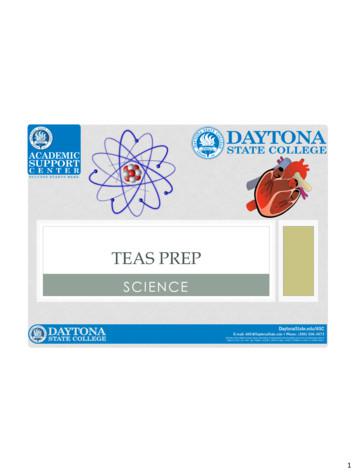Human Anatomy And Physiology II Laboratory
Mpeg 4 for iPodmp3Human AnatomyandPhysiology IILaboratoryTheRespiratory System1This lab involves two exercises in the lab manual entitled “Anatomy of the RespiratorySystem” and "Respiratory System Physiology".In this lab you will look at lung histology, gross anatomy, and physiology.Complete the review sheets from the exercise and take the online quiz onrespiration, As an alternate your instructor may have you submit a drawing of lungtissue from the Virtual Microsocpe or other histology site. Use the PhysioEXsoftware to measure an analyze respiratory volumes.There is also a video showing cadaver dissection of the respiratory tract.Click on the sound icon for the audio file (mp3 format) for each slide.There is also a link to a dowloadable mp4 video which can be played on an iPod.1
Respiratory TractNasal cavityRibcage(thoracic wall)Respiratory tree(Lower xLarynxTrachea1o BronchiPleuraeDiaphragm2The respiratory tract can be thought of as consisting of two parts: the upperrespiratory tract has the nasal cavity, and the pharynx; The lowerrespiratory tract has the larynx and the respiratory tree from the tracheathrough the various divisions of bronchi to the bronchioles. Essentially theupper division is where the cilia beat down to move mucus down to thethroat to be swallowed, and the lower division is where cilia be up to movemucus to the throat to be swallowed.2
Upper Respiratory Tract3See the Lab Manual for items you are responsible for inthe Upper Respiratory Tract.3
The LarynxAnterior viewepiglottisHyoid boneThyroid cartilageCricoid cartilageTrachea4Mispronunciation of the larynx is an anatomical pet peeve. It is pronouncedlair-inks, and consists of anumber of cartilages along with the ligamentswhich connect them. The larynx is connected to the hyoid bone by thethryrohyoid ligament. The thryroid cartilage is the largest and its anteriorprominence is the “Adam’s Apple”.4
Sagittal Section of the LarynxEpiglottisArytenoidcartilageArytenoid musclesThyroid cartilageCricoid cartilageTracheaHyoid bonePomum Adamii(Adam’s Apple)Vestibular folds(false vocal cords)Vocal folds (truevocal cords)5When you swallow the hyoid bone lifts up and this causes the cartilaginousepiglottis to hinge backwards, guarding the opening into the glottis toprevent aspiration. The glottis is the opening between the vocal folds,which are the vocal cords. The vocal folds are guarded by the vestibularfolds. The arytenoid cartilage, controlled by arytenoid muscles, swivelsto regulate tension on the vocal folds in producing the pitch of the voice.5
Respiratory Tree(Dissected andPrimarybronchi6A dissected cadaver specimen of the larynx with its attachment to therespiratory tree.6
Larynx, anterior viewThyroid cartilageCricothyroid muscleCricoid cartilage7The many small muscles found attached to the larynx have been removedfrom this specimen, along with the thyroid gland.7
Larynx, posterior viewEpiglottishyoid boneAryepiglotticfold andmusclePiriform recessCricoarytenoid muscleSuperior horn ofthyroid cartilageArytenoidmusclesCricoid cartilageMembraneouspart of trachea8The epiglottis is not a separate “leaf-like” structure as it is often pictured, butrather is attached to the aryepiglottic fold to form more of a trumpet shape.8
Larynx, sagittal sectionEpiglottisThyroid cartilageVestibular foldventricleVocal foldVocalis muscleCricoid daver larynx in sagittal section.9
Glottis, superior viewepiglottisGlottisVestibular foldVocal foldAryepiglottic foldInterarytenoidnotch10A view of the glottis from above. When sound is produced the vocal foldstighten and loosen to produce different pitches, controlled by the arytenoidcartilages and arytenoid muscles.10
Laryngeal Cartilages, anterior viewEpiglottisHyoid boneLesser cornuGreater cornuBodyThyroepiglottic ligamentCornus elasticusCricothyroid ligamentThyroidcartilageCornus elasticusCricoid cartilage11When the soft tissues are removed, the cartilages of the larynx are distinct.11
There is noaudio filefor thisslide.Laryngeal Cartilages, posterior viewLesser cornu of hyoid boneEpiglottisThyroepiglottic lig.Thyroid cartilageGreater cornu of hyoid boneThyrohyoid ligamentSup. Cornu ofthyroid cartilageCorniculate cartilageArytenoid cartilageCricoarytenoid jointCricoid cartilagePost. CricoarytenoidCricothyroidjointlig.Trachea1212
C.S. Trachea & EsophagusEsophagusMembraneousportion of trachea(trachealis muscle)FibrouscoveringC-ring cartilageP.C.C.E.Seromucous glands13A cross section of the trachea at the level of one of the C-ring cartilagesshows how the esophagus fits into the membraneous portion of the trachea.This permits swallowing of a bolus of food. The trachealis muscle actually isa complete layer around the trachea, but is thicker at the posterior portion.Within the submucosa of the trachea lie seromucous glands. The mucousthey secrete helps to remove particulates through the action of the ciliatedlining tissue (PCCE).13
The Respiratory TreeCricoid cartilageTracheal cartilages18 Tertiarybronchi (tobronchopulmonarysegments)2 Primary bronchi (to each lung)5 Secondary bronchi(to each lobe)Subsegmental bronchi – large and small,about 20 generations.14This is the bronchial portion of the respiratory tree.14
Respiratory ZoneConducting zone:mucosa lined,allows no gasexchange withblood.Respiratory zone: thinwalled simple squamousepithelium, allows gasexchange with blood.15The large bronchioles and terminal bronchioles are still part of theconducting zone, which gets the air to and from the internal alveolar sacs ofthe lungs. The respiratory bronchioles and alveolar sac systems are therespiratory zone, the part which allows gas transport by diffusion betweenthe lungs and the blood.15
Branch into Respiratory Bronchiole16The respiratory zone structures are composed of simple squamousepithelium for transport.16
A BronchusHyalinecartilage platePseudostratifiedciliated columnarepitheliumSmoothmuscle17Also see photos available on The Virtual MicroscopeA bronchus, at whatever level, is lined with pseudostratified ciliated columnarepithelium. Smooth muscle and a small amount of cartilage are also present.17
AlveoliCapillariesSmooth muscleAlveolusElasticfibers18Alveolar sac systems (the sacs and their alveoli and ducts which lead tothem) are simple squamous epithelium. Note how the alveoli, the littlechambers, are surrounded by blood capillaries for transport. A smallamount of elastic tissue forms the stroma of the lungs, and permitselasticity and recoil.18
Alveolar Sacs and AlveoliAlveolar saccapillaryAlveolar SacSimplesquamousepithelium19Lung tissue seen under the microscope looks much like a sponge mightlook. The thin walls of simple squamous epithelium incorporate bloodcapillaries, the tiny spaces.19
AlveolicapillaryType I cellType II cell20In this extremely high magnification view the nuclei of the Type I (structural)simple squamous cells are visible, along with Type II surfactant-secretingcells. Note the capillaries with red blood cells within them.20
IRV: The amount which can beforcefully inhaled after a normalresting inhalation.The residual volume is the air left in the lungsafter a maximal expiration.The Respiratory VolumesTidal volume: thevolume of a singlebreath, usually at rest.ERV: The amount which canbe forcefully expired after anormal resting expiration21In a lab you might record a spirograph, similar to this one, and meaure thevalues shown. You may also use PhysioEX to measure and analyzehypothetical respiratory volumes.21
The Vital CapacityTVTV IRVIRV ERVERV ntofairwhichthe maximum amount of air ebreath.breath.TheVCshouldbe80%oftotalThe VC should be 80% of totallunglungcapacity.capacity.22You may also use the small handheld spirometers to measure the VitalCapacity, a useful measurement for evaluating respiratory perfomance.22
The FEV1Expiration Inspiration1Sec.VCThe FEV1 is theportion of thevital capacityexpelled in thefirst second.TV23An obstructive disorder such as bronchitis or asthma does not, by itself,reduce the vital capacity. It does impede the airways and reduce the easyand rate of expiration. This is measured with the FEV1, which should be atleast 75% of vital capacity.23
The FEV1Expiration Inspiration1 Sec.VCThe FEV1 is theportion of the vitalcapacity expelledin the first second.A person with an obstructive disorder has difficultyexpelling the VC and the proportion expelled in thefirst second decreases below 75%24Here you can see the effect of an obstructive disorder, somewhatexaggerated, in reducing the FEV1.24
There is noaudio filefor thisslide.Lab Protocol1) Complete the Review Sheet for this exercise .2) Take the quiz on the respiratory system.3) Use ADAM to identify structures of the respiratorysystem. (See next slide)4) Use PhysioEX to measure and analyze respiratoryvolumes.5) View the cadaver video on the respiratory tract.ADAM Interactive AnatomyDissectible Anatomy, Male, Anterior, Window centered on chest, Layer indicator25162Dissectible Anatomy, Male, Anterior, Window centered on chest, Layer indicator252, scroll from diaphragm to larynx.Dissectible Anatomy, Male, Medial view, Window centered on chest, Layer indicator35, Window centered on nasal cavityDissectible Anatomy, Male, Medial view, Window centered on chest, Layer indicator96, Window centered on left lung.Atlas Anatomy, Region, Thorax, Bronchial Tree (Ant)Atlas Anatomy, Region, Thorax, Bronchial Tree (Post)25
Lab ProtocolADAM Interactive AnatomyDissectible Anatomy, Male, Anterior, Window centered onchest, Layer indicator 162Dissectible Anatomy, Male, Anterior, Window centered onchest, Layer indicator 252, scroll from diaphragm to larynx.Dissectible Anatomy, Male, Medial view, Window centered onchest, Layer indicator 35, Window centered on nasal cavityDissectible Anatomy, Male, Medial view, Window centered onchest, Layer indicator 96, Window centered on left lung.Atlas Anatomy, Region, Thorax, Bronchial Tree (Ant)Atlas Anatomy, Region, Thorax, Bronchial Tree (Post)2626
Human Anatomy and Physiology II Laboratory The Respiratory System This lab involves two exercises in the lab manual entitled “Anatomy of the Respiratory System” and "Respiratory System Physiology". In this lab you will look at lung histology, gross anatomy, and physiology. Complete the review sheets from the exercise and take the online quiz on
Anatomy & Physiology 2019: Correlations 2 Essentials of Human Anatomy, 10th Edition by Elaine N. Marieb Human Anatomy & Physiology, 9th Edition by Elaine N. Marieb and Katja Hoehn Fundamentals of Anatomy and Physiology, 9th Edition by Frederic H. Martini, Judi L. Nath, and Edwin F. Bartholomew Anatomy &
Clinical Anatomy RK Zargar, Sushil Kumar 8. Human Embryology Daksha Dixit 9. Manipal Manual of Anatomy Sampath Madhyastha 10. Exam-Oriented Anatomy Shoukat N Kazi 11. Anatomy and Physiology of Eye AK Khurana, Indu Khurana 12. Surface and Radiological Anatomy A. Halim 13. MCQ in Human Anatomy DK Chopade 14. Exam-Oriented Anatomy for Dental .
Preliminary Human anatomy and Physiology Basic concepts of human anatomy Basic concepts of human physiology Suggested Reading: Human Anatomy- Prof. Samar Mitra Human Anatomy- Prof. A. K. Dutta Text Book of Human Physiology- Dr. C. C. Chatterjee Common Pathological Con
HUMAN ANATOMY AND PHYSIOLOGY Anatomy: Anatomy is a branch of science in which deals with the internal organ structure is called Anatomy. The word “Anatomy” comes from the Greek word “ana” meaning “up” and “tome” meaning “a cutting”. Father of Anatomy is referred as “Andreas Vesalius”. Ph
8 Respiratory Physiology 9 Respiratory physiology I 10 Renal Physiology 11 Digestive Physiology (spring only) 12 Lab exam 2 ** ** For an accurate display of lab dates and exam dates please consult the Human Anatomy and Physiology II web site. Laboratory assessment will be as follows: Total 1. Introductory exercise 10 2.
Human Anatomy and Physiology (32 questions) Describe the general anatomy and physiology of a human. Describe the anatomy and physiology of the respiratory system. Describe the anatomy and physiology of the cardiovascular system. Describe the anatom
39 poddar Handbook of osteology Anatomy Textbook 10 40 Ross ,Pawlina Histology a text & atlas Anatomy Textbook 10 41 Halim A. Human anatomy Abdomen & lower limb Anatomy Referencebook 10 42 B.D. Chaurasia Human anatomy Head & Neck, Brain Anatomy Referencebook 10 43 Halim A. Human anatomy Head & Neck, Brain Anatomy Referencebook 10
Introduction Origami is the art of folding 2D materials, such as a flat sheet of paper, into 3D objects with desired shapes. Since early 1980s, origami has evolved into a fertile scientific field connecting diverse disciplines, creating an























